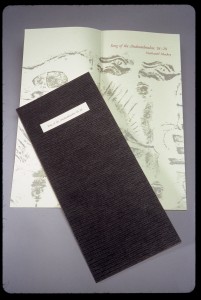Poems by Nathaniel Mackey
Images based on the sculpture of Doyle Foreman
Edition of 150, signed and numbered
6 1/2″ x 14 1/2″
24 pages
ISBN 0-939952-16-5
$166 out of print due to 8/20 fire
First to be born were the Yeban, small creatures with big heads, discolored bodies, and frail limbs who, for shame of their condition, hide in the holes of the earth. They coupled and gave birth to the Andoumboulou, who are even smaller than they are…. Thus, the earth’s interior became slowly populated with these beings…
—Marcel Griaule and Germaine Dieterlen, THE PALE FOX
ABOUT THE BOOK
Published in association with the University of California, Santa Cruz, Song of the Andoumboulou: 18–20 is a fine press artists’ book forged from the poetry of Nathaniel Mackey and the sculpture of Doyle Foreman. The poems comprise three installments from Mackey’s ongoing serial work, “Song of the Andoumboulou,” whose title is drawn from ritual music of the Dogon in Mali. Mackey’s poems project African and Iberian ceremonial figures and jazz iconography onto a rhythmic understructure, creating a vehicle that journeys through elemental landscapes reminiscent of Foreman’s bas-relief compositions. This movement is reflected in the book where the poems are typeset to dance down each page, suggesting multiple readings.
ABOUT THE POET
Poet and critic Nathaniel Mackey, was a professor of literature at UCSC between 1979–2010. He has been the editor/publisher of the literary magazine Hambone since 1982, and won the National Book Award for Poetry in 2006. He is currently a professor at Duke University. Mackey previously worked with book artist and publisher Felicia Rice as part of Moving Parts Press’ 1991 Porter Broadside Series. That collaboration produced a pairing of Mackey’s Song of the Andoumboulou: 8 with lithographer Paul Rangell’s imagery.
ABOUT THE ARTIST
Doyle Foreman, professor of art at UCSC, taught clay and bronze sculpture, and African art there beginning in 1968. His bronze, bas-relief sculptures use forms drawn from nature. Rather than producing copies of his subjects, Foreman captures their spirit and feeling by presenting his imagery in intimate natural relationships.
ABOUT THE COLLABORATION
Foreman and Mackey’s acquaintance dates back to the ’70s, to the Yardbird Publishing Cooperative, an association of Afro-American writers, artists, scholars and businessmen. Between the forms and geometry of Foreman’s sculpture and his own poetic forms Mackey sees “a poetic rapport.” Says Mackey: “The appearance in the first poem of Ogun, the West African orisha or god of iron and metal-working, relates in my mind to Doyle’s working in metal and his travels in West Africa.” The relationship between Foreman’s bronze casting and letterpress printing intrigued Rice. “While bas-relief, bronze-casting begins with a two dimensional flat surface and results in a three-dimensional sculpture,” explains Rice, “relief printing pulls an image from a three-dimensional plate onto the flat of the printed page. This inversion, this mirroring is reflected in the images within the book.
